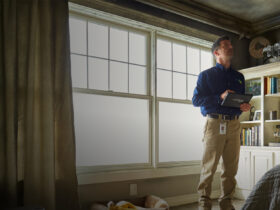Every year, termites cause over $5 billion dollars in property damage. A small infestation can soon turn into a huge issue that can cost large amounts of money to fix.
In order to prevent this from happening to your home, it’s important to know how to identify termites, prevent an infestation, and stop one quickly if it happens. Let’s take a look at what you need to know as a homeowner to stop a termite infestation.
Problems Caused by Termites
Termites like to eat the cellulose in wood. This can include wood that is in your home’s structure or walls. They especially like wood that is in contact with soil.
When they eat this wood, termites can cause very expensive damage. They can even compromise the structural integrity of the home. In some cases, you may not see the actual termites. They can cause a lot of damage before you have the chance to stop them.
Unfortunately, many homeowners insurance policies won’t cover damage caused by termites. This can make their damage even more troublesome.
Luckily, termites don’t bite or transmit disease. Their damage to homes and possessions is the cause for most concern.
Types of Termites
There are two main types of termites, subterranean and drywood. Knowing what type of termites you may face is important. They have different characteristics, and therefore, different signs of infestation, prevention methods, and treatments.
Subterranean termites are the most common type found in homes. This kind likes to feed on different wood sources. They build large colonies underground. Subterranean termites also build mud tubes to travel between their colony and food source.
These tubes give them the moisture that they need to survive. These tunnels can become massive, up to 150 feet long.
Drywood termites are most common in the Southeast and Southwest United States. They don’t need to come in contact with soil to get into homes. Drywood termites can infest wood inside the home’s structure, as well as wooden furniture.
Signs of a Termite Infestation
Termites usually eat wood from the inside out. You may not be able to see the damage, but the wood may still be damaged and hollow inside.
Knock on the wood to see if it sounds hollow. You can also press a screwdriver into the wood to see if it gives easily. Rotting wood may be an accompanying sign.
Moisture can enter the area between the surface and paint if termites damage drywall. The paint may begin to bubble or peel. While this damage could be caused by other issues, if you notice other signs of termites, it may indicate an infestation.
Since these tubes allow subterranean termites to travel, you may see them between the colony and infested parts of the home. They are usually found near the foundation, basement, or crawlspace. These tubes are about as wide as a pencil.
If you see mud tubes near your home, you almost certainly have a termite problem. However, you can have an infestation even if you don’t see any tubes.
Termites leave frass behind when they are eating through wood. It may look like powdered shavings or small, granular, oval pellets. Usually, frass is found near door frames, baseboards, or windowsills.
Termites are sometimes confused with flying ants, which look similar but have some differences. You may see young females or winged termites in your home during the spring. Be sure to keep an eye out for ant-like insects, with or without wings.
You may also see discarded wings on the ground near where a swarm was.
Termites bang their heads and shake their bodies as a signal to each other if they detect danger. You may hear a clicking sound inside the walls if there is an issue.
How to Prevent an Infestation
The first step to stopping termites is to keep an eye out and prevent them from becoming a problem in the first place.
Keep mulch at least 15 inches away from your foundation. You can also switch it out for mulch made from rubber or gravel. Keep wood, including firewood, at least 20 feet away from the house. It should also be at least 5 inches from the ground.
Seal cracks and holes in your home’s exterior. Use caulk in openings between the foundation and pipes, as well as around windows and doors. Also, check for any leaks around the house.
Watch exterior wood for signs of damage. Door frames, windows, and skirting boards may show signs of damage first.
Make sure water drains away from the house since termites need moisture to survive. Keep gutters and downspouts clean.
Keep your attic, basement, and crawlspace dry and ventilated. You should also schedule a regular home inspection from a pest professional.
How to Get Rid Of Termites
If you suspect you may have termites, you need to get a handle on the infestation immediately.
It can be difficult to stop termites by yourself. You should call a pest professional who knows how to kill termites quickly and efficiently.
While some pest treatments are available to homeowners, some such as fumigation should never be done by yourself. They can be dangerous without proper training. It is much better to have a professional get the termite problem under control.
A knowledgeable professional such as Altuspest.com can assess the situation, find where the colony is, and how they enter your home. This will allow them to create a personalized plan for how to take care of the infestation.
Stop Termites from Becoming a Problem
Prevention is the best way to keep termites from becoming a problem. Be sure to watch for the signs of a termite infestation and take steps to keep them away. If you do suspect an infestation, contact a pest control company right away.
If you enjoyed this article, be sure to read our other ones too.








